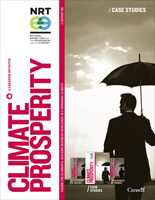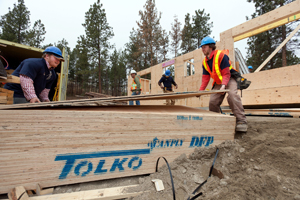Tolko Industries Ltd. – Case Study
FACING THE ELEMENTS: Building Business Resilience in a Changing Climate
|
“Tolko’s woodlands teams have risen to the challenges of forest management in today’s changing world.”– Randy Chan, Vice President Forestry & Environment |

|
AT A GLANCE // |
Location:Vernon, British Columbia Industry:Wood product manufacturing Employees (2010):2,200 Total Sales (2010):over C$50 million |
Key adaptation
|
Adaptation
|
Business BenefitsMore resilient woodland |
Business ChallengesCost and lack of economic incentives |
COMPANY OVERVIEW //
VERNON, BRITISH COLUMBIA
www.tolko.com

Habitat for Humanity project, Kelowna
(photo credit: Tolko Industries Limited)
Tolko produces a broad range of forest products, including the following:
Lumber; plywood, veneer and other manufactured wood products; oriented strand board (OSB); manufactured ties, poles and timbers for the transport industry (such as railway or dock construction); by-products, including wood chips and kraft paper for packaging and other uses.
Lumber represents the majority of the company’s sales. Tolko also owns and operates eight biomass energy facilities that produce heat or biogas from wood residues for the company’s operations. Two of those facilities are combined heat and power plants producing electricity sold to BC Hydro and other power utilities.
FOREST-BASED ACTIVITIES IN A CHANGING CLIMATE
Climate change is already affecting Canada’s forests and will continue to do so in the foreseeable future.22 Forest managers and timber companies are beginning to assess the implications of climate change for drought and fire risk, pest and disease outbreaks and forest productivity.
Some of these biophysical impacts are already being felt:
// In recent years, considerable fire activity in the western boreal forest and the Yukon has been linked in part to a changing climate.23 In the future, higher temperatures (particularly heat waves) and seasonal drought conditions could increase fire risk to forests.
// The economic implications of a shift in the distribution of forest pests and diseases are considerable. These shifts can contribute to tree mortality, reduce woodlands’ resilience to climatic stresses (such as droughts) and aggravate fire risk by clearing large portions of forest. Climate change has exacerbated recent mountain pine beetle (MPB) outbreaks. In recent years, unusually hot, dry summers (favourable for beetle reproduction) and mild winters (which allow beetle larvae to survive), have contributed to MPB infestations destroying more than 700 million m3 of pine in BC; this represents more than 50% of the province’s commercially important pine. The geographic distribution of this species is expected to move northward and eastward into habitat that was formerly limited by climate.24
// Forests in Western Canada have suffered record dry conditions in the recent past. Drought episodes in 2001-2003 caused widespread forest dieback and mortality.25 Studies show that some forest areas, particularly the low-elevation southern portion of the western boreal forest,26 could experience considerable decline in productivity due to increased drought in the future.
// The bioclimatic suitability of different tree species will also shift in a changing climate, leading to changes in yield forecasts. In anticipation of future warming, the BC Ministry of Forests and Range has made climate-based upward elevation changes to the Chief Forester’s Standards for Seed Transfer, raising elevation limits for some species by 100-200m.27
Climate change is likely to affect access to standing timber. Timber is often harvested on frozen soils, because high soil moisture and the risk of soil compaction from heavy machinery restrict access during warmer seasons. Warmer temperatures and changing patterns of precipitation could shorten the period during which timber companies can safely harvest wood.
The impacts of climate change on wood manufacturing activities are less well understood. Weatherrelated delays and disruptions to transport of wood products could increase. As well, higher temperatures could reduce the efficiency of biomass energy production facilities and changing availability of water could reduce cooling capacity.
A changing climate has significant implications for the health of forest ecosystem services, such as biodiversity and carbon sequestration. Forest-based communities will see their standard of living affected if woodland health diminishes in a changing climate. These impacts could have consequences for companies with strong forest stewardship commitments.
The risk of negative impacts on forest-based communities and forest ecosystems is compounded by the fact that timber harvesting activities are increasingly under scrutiny by government agencies and the public.
A number of sustainable forest management certification schemes are considering integrating climate risk management into their standards and audit requirements.g
Finally, climate change could lead to changes in forest product trade patterns, since forest cover will increase in certain countries at the same time as forest health declines in other places. Two studies suggest that Canadian forest product companies are particularly vulnerable to climate change impacts compared with competitors from other countries.28
DRIVERS
Tolko manages large areas of woodland, primarily from natural reproduction and regeneration, across British Columbia, Alberta, Saskatchewan and Manitoba. The company owns little freehold land; the majority of its timber stands are leased from the Crown. Since most of the stands Tolko manages are publicly owned, the company feels a strong obligation to manage forests in a sustainable manner.
Tolko has made clear commitments to sustainable forest management to preserve the quality of life of surrounding communities and maintain the environmental, social and economic benefits of woodlands for future generations. For example, the company maintains sustainable forest management certification from the Canadian Standard Association (CSA Z809) on all of its woodlands.
The company has already been affected by a number of climate-related impacts in recent years. In response to mountain pine beetle infestations, Tolko has invested in innovative technology to extract maximum economic value from MPB-damaged timber.29 To counter increased fire risk, the company has selectively harvested Douglas fir stands to protect planned roads in an area close to Williams Lake, BC.30 Finally, Tolko manages humid forest areas that have experienced droughts in recent years.
A FOCUS ON BOOSTING FOREST RESILIENCE
The company’s leadership developed an early interest in climate change impacts and adaptation. In its 2008 Sustainability Report Tolko recognized the need to develop integrated and adaptive strategies to cope with the impacts of a changing climate.
Tolko chairs the Timber Supply Area team of the Kamloops Future Forest Strategy (KFFS), a new initiative that involves the B.C. government, First Nations, academics and other industry representatives. The KFFS recognizes climate change as a significant challenge to the forest sector, and aims to guide forest management activities and investments towards a more diversified, resilient future. Tolko manages woodlands and has operations within the KFFS area, which is dominated by Douglas firs, lodgepole pine and spruce. The area is also characterized by considerable bioclimatic diversity.
To manage the uncertainty of future climate change, the KFFS team has used a range of plausible climate change impact scenarios, and recommended a number of adaptation approaches to minimize the impacts of climate change on forests and maintain ecological, economic and social benefits of forest areas.
The KFFS team undertook the following activities between 2007 and 2009:
// It modelled future climate and ecosystem composition, and mapping projected changes;
// It assessed the climate change sensitivity of ecological zones and forest management regimes in the Kamloops timber supply area;
// It development climate change adaptation options.
This work showed that 60% of the timber that can be harvested within the Kamloops area is expected to suffer a moderate to high degree of ecological alteration due to climate change by 2080. The KFFS team made a number of recommendations for successfully adapting woodlands in the Kamloops area, including:
// Promote species diversity and limiting climate-induced tree mortality by favouring resilient species, such as Douglas fir.
// Proactively harvest high-risk tree stands to realise economic value before trees are damaged by changes in climatic conditions.
// Carefully promote broadleaf species as they hold benefits for conservation and fire risk management, keeping in mind their vulnerability to dry. conditionsh.
Tolko has built on the efforts of the KFFS initiative, making a number of changes in its forest management practices to build resilience. The company has refined its site selection process, paying more attention to local bioclimatic conditions (soil composition, exposure to drought, etc.) before making decisions about tree species and planting density. At a micro-site level, Tolko now strives to avoid soils that are considered to be vulnerable to climatic stresses, particularly shallow soils exposed to drought conditions. The company has also increased the proportion of Douglas firs in certain forest areas (for example, where lodgepole pines dominate) to increase resilience and improve carbon sequestration. For more than 10 years, Tolko has practised mixed bag planting over monoculture, with an increasing focus on multi-species and a higher proportion of drought-resistant species. The company also carefully selects microsites for optimum seedling health and growth, experimenting with intertree spacing to avoid thin soils, and avoiding sites that have previously produced poor results because of shallow or drought-sensitive soils. More importantly, this diversity increases the capacity of a timber stand to cope with different possible climate futures, in line with the ecological concept of “resilience”.
Finally, the company is taking small steps to change its corporate culture so as to integrate climate change contingencies. For example, Tolko now considers the potential for more conservative forest yield forecasts to manage future uncertainty.
BENEFITS AND/OR CHALLENGES
Tolko believes the steps it has taken to adapt its forest management practices will help its woodlands better cope with future climate change.
The company is now considering how far down the “climate change adaptation” journey it wants to go, given its strong sustainability values and policy. Presently, a key barrier Tolko is facing in this area is the lack of economic incentive. Adaptation has an upfront cost. For example, Tolko pays an additional 10-15 cents for each new Douglas fir planted to increase forest resilience (compared to cheaper pine species).
PERSPECTIVES ON GOVERNMENT ROLES
Climate change adaptation is a long journey for businesses. There are a number of things government should put in place before forest product companies can implement a comprehensive adaptation strategy on Crown land.
Government has a role in supporting research on climate change impacts and adaptation solutions for forest-based activities. Government should also guarantee a “level-playing field”, with economic incentives offered to companies making climate adaptation efforts. Because historic forest management practices are unlikely be robust in the future, comprehensive private sector adaptation requires a cultural change involving forest product suppliers, customers, and forest-based communities.
[g] For example, the new version of the Canadian Standard Association standard for sustainable forest management (Z809-08, Sustainable Forest Management) has provisions for exploring climate change impacts and adaptation. The Forest Stewardship Council or FSC (another leading international certification and labeling scheme) is exploring possible strategic engagement options on climate change adaptation. See Canadian Standards Association 2008 and Forest Stewardship Council Forest Carbon Working Group 2010.
[h] For instance, drought has recently caused significant mortality of aspen trees in the southern boreal forest of Alberta and Saskatchewan. See Johnston and et al. 2009.
[22] Johnston et al. 2010
[23] Johnston et al. 2010
[24] Carroll et al. 2003
[25] Hogg and Bernier 2005
[26] Hogg and Bernier 2005
[27] British Columbia Ministry of Forests and Range 2008
[28] Sohngen and Sedjo 2005
[29] Tolko NDa
[30] Tolko NDb








































